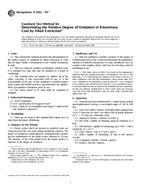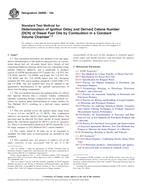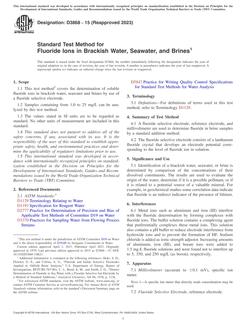1.1 This guide covers procedures for obtaining laboratory data concerning the adverse effects of a test material added to growth medium on growth of certain species of freshwater and saltwater microalgae during a 96-h static exposure. These procedures will probably be useful for conducting short-term toxicity tests with other species of algae, although modifications might be necessary.
1.2 Other modifications of these procedures might be justified by special needs or circumstances. Although using appropriate procedures is more important than following prescribed procedures, results of tests conducted using unusual procedures are not likely to be comparable to results of many other tests. Comparison of results obtained using modified and unmodified versions of these procedures might provide useful information concerning new concepts and procedures for conducting toxicity tests with microalgae.
1.3 These procedures are applicable to many chemicals, either individually or in formulations, commercial products, or known mixtures. With appropriate modifications, these procedures can be used to conduct tests on temperature, dissolved oxygen, and pH and on such materials as aqueous effluents (see also Guide E 1192), leachates, oils, particulate matter, sediments, and surface waters. Static tests might not be applicable to materials that have a high oxygen demand, are highly volatile, are rapidly biologically or chemically transformed in aqueous solutions, or are removed from test solutions in substantial quantities by the test vessels or organisms during the test. However, practical flow-through test procedures with microalgae have not been developed.
1.4 Results of tests using microalgae should usually be reported in terms of the 96-h IC50 (see ) based on reduction in growth. In some situations, it might only be necessary to determine whether a specific concentration unacceptably affects the growth of the test species or whether the IC50 is above or below a specific concentration.
1.5 This guide is arranged as follows:
| Section | |
| Referenced Documents | 2 |
| Terminology | 3 |
| Summary of Guide | 4 |
| Significance and Use | 5 |
| Hazards | 7 |
| Apparatus | 6 |
| Facilities | 6.1 |
| Equipment | 6.2 |
| Test Vessels | 6.3 |
| Cleaning | 6.4 |
| Acceptability | 6.5 |
| Growth Medium | 8 |
| Test Material | 9 |
| General | 9.1 |
| Stock Solution | 9.2 |
| Test Concentration(s) | 9.3 |
| Test Organisms | 10 |
| Species | 10.1 |
| Source | 10.2 |
| Culture | 10.3 |
| Quality | 10.4 |
| Procedure | 11 |
| Experimental Design | 11.1 |
| Temperature | 11.2 |
| Illumination | 11.3 |
| Beginning the Test | 11.4 |
| Gas Exchange | 11.5 |
| Duration of Test | 11.6 |
| Biological Data | 11.7 |
| Other Measurements | 11.8 |
| Determination of Algistatic and Algicidal Effects | 11.8.5 |
| Analytical Methodology | 12 |
| Acceptability of Test | 13 |
| Calculation | 14 |
| Report | 15 |
| Keywords | 16 |
1.6 This standard does not purport to address all of the safety concerns, if any, associated with its use. It is the responsibility of the user of this standard to establish appropriate safety and health practices and determine the applicability of regulatory limitations prior to use. Specific hazard statements are given in Section 7.
Product Details
- Published:
- 10/10/1997
- Number of Pages:
- 14
- File Size:
- 1 file , 120 KB


